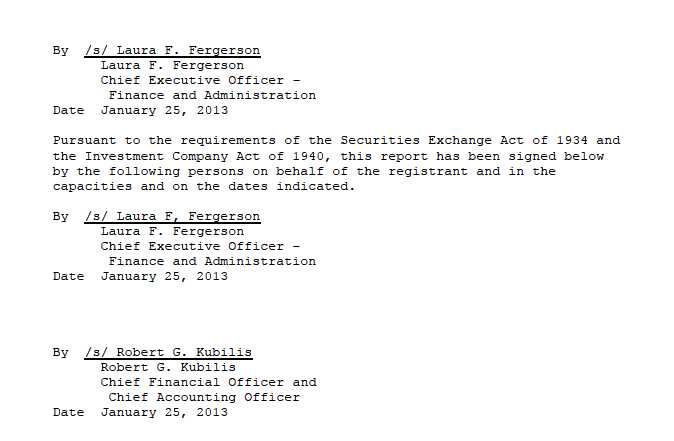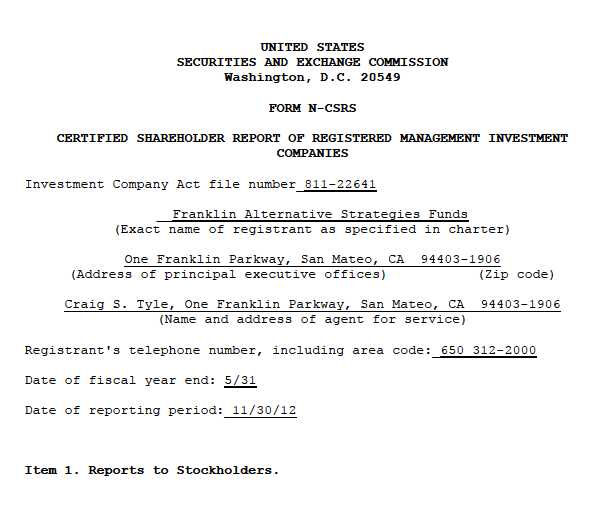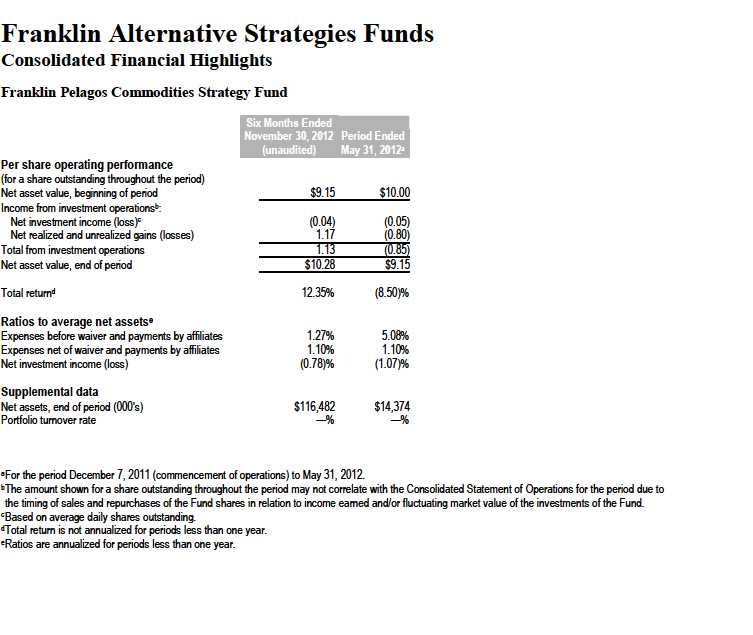
Semiannual Report | The accompanying notes are an integral part of these consolidated financial statements. |1
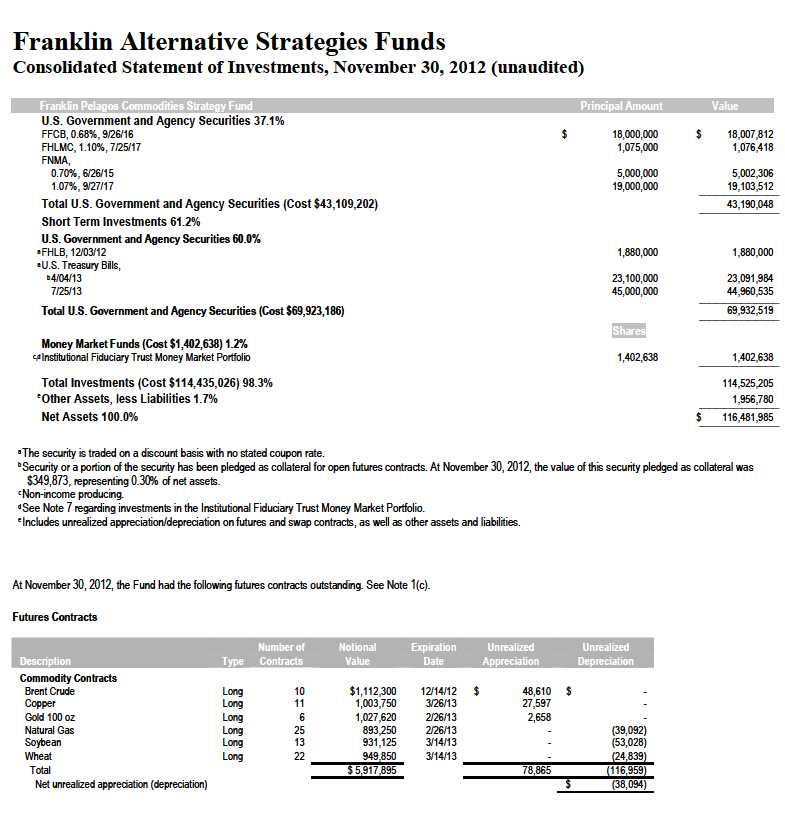
Semiannual Report | The accompanying notes are an integral part of these consolidated financial statements. |2
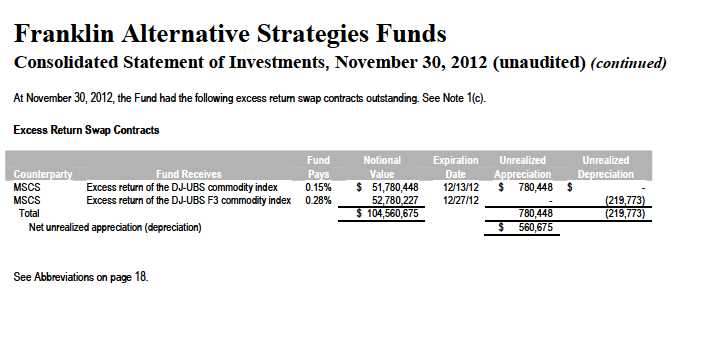
Semiannual Report | The accompanying notes are an integral part of these consolidated financial statements. |3
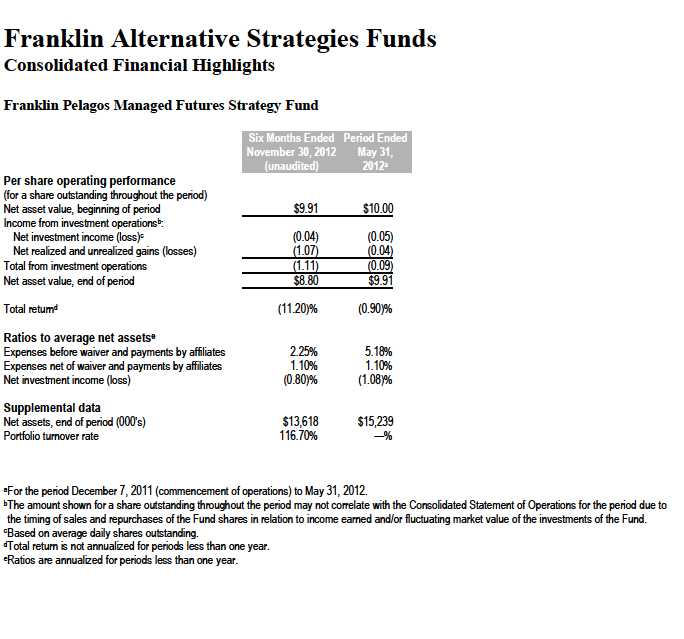
Semiannual Report | The accompanying notes are an integral part of these consolidated financial statements. |4
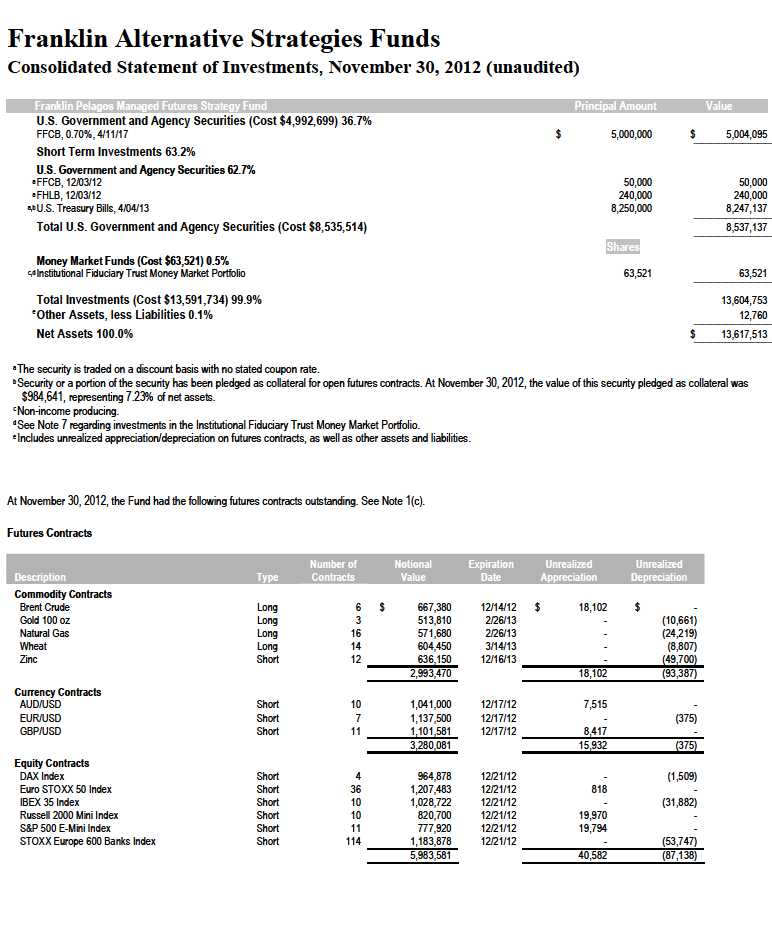
Semiannual Report | The accompanying notes are an integral part of these consolidated financial statements. |5
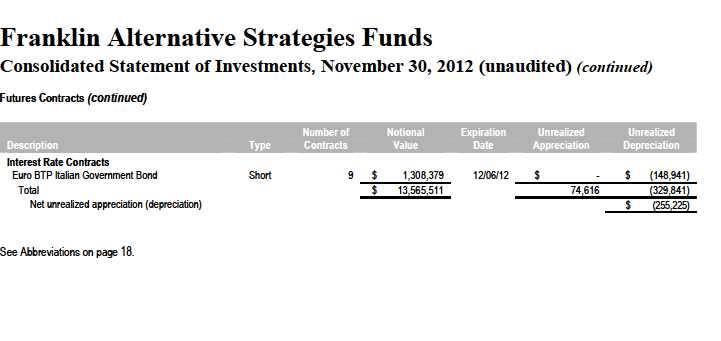
Semiannual Report | The accompanying notes are an integral part of these consolidated financial statements. |6
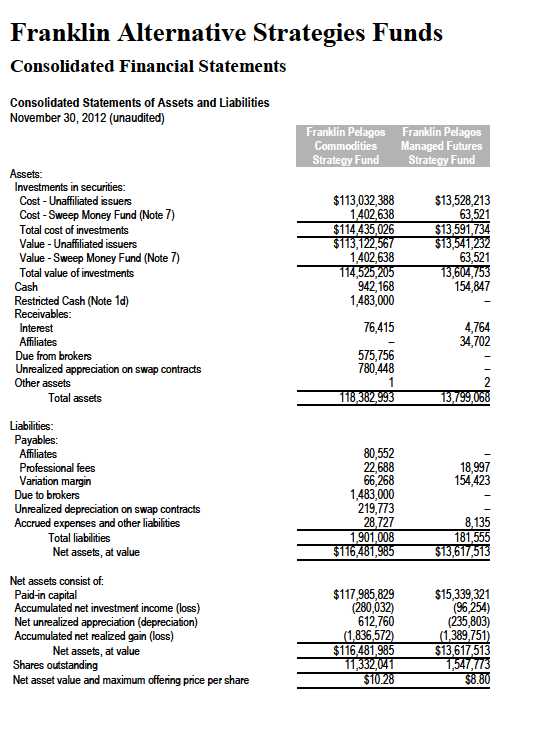
Semiannual Report | The accompanying notes are an integral part of these consolidated financial statements. |7

Semiannual Report | The accompanying notes are an integral part of these consolidated financial statements. |8
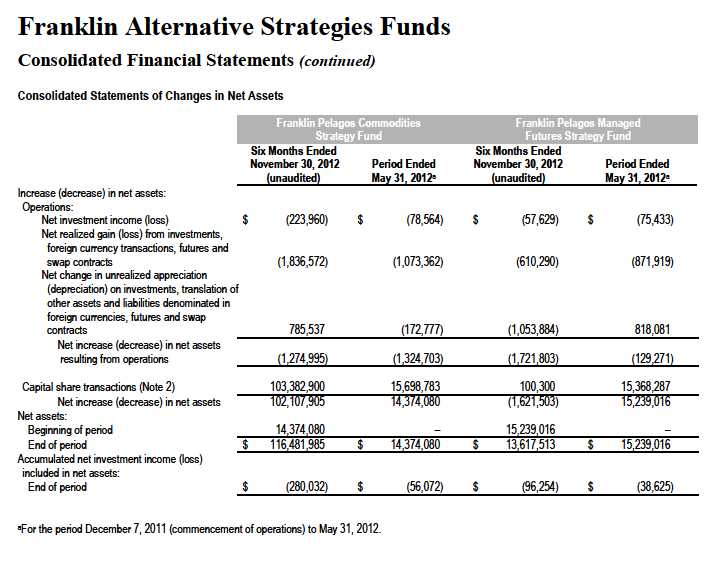
Semiannual Report | The accompanying notes are an integral part of these consolidated financial statements. |9
Franklin Alternative Strategies Funds
Notes to Consolidated Financial Statements (unaudited)
1. ORGANIZATION AND SIGNIFICANT ACCOUNTING POLICIES
Franklin Alternative Strategies Funds (Trust) is registered under the Investment Company Act of 1940, as amended, (1940 Act) as an open-end investment company, consisting of two funds, the Franklin Pelagos Commodities Strategy Fund and the Franklin Pelagos Managed Futures Strategy Fund (Funds). The shares of the Funds are issued in private placements and are exempt from registration under the Securities Act of 1933.
The following summarizes the Funds' significant accounting policies.
a. Financial Instrument Valuation
The Funds' investments in financial instruments are carried at fair value daily. Fair value is the price that would be received to sell an asset or paid to transfer a liability in an orderly transaction between market participants on the measurement date. Under procedures approved by the Trust's Board of Trustees (the Board), the Funds' administrator, investment manager and other affiliates have formed the Valuation and Liquidity Oversight Committee (VLOC). The VLOC provides administration and oversight of the Funds' valuation policies and procedures, which are approved annually by the Board. Among other things, these procedures allow the Funds to utilize independent pricing services, quotations from securities and financial instrument dealers, and other market sources to determine fair value.
Debt securities generally trade in the over-the-counter (OTC) market rather than on a securities exchange. The Funds' pricing services use multiple valuation techniques to determine fair value. In instances where sufficient market activity exists, the pricing services may utilize a market-based approach through which quotes from market makers are used to determine fair value. In instances where sufficient market activity may not exist or is limited, the pricing services also utilize proprietary valuation models which may consider market characteristics such as benchmark yield curves, credit spreads, estimated default rates, anticipated market interest rate volatility, coupon rates, anticipated timing of principal repayments, underlying collateral, and other unique security features in order to estimate the relevant cash flows, which are then discounted to calculate the fair value. Investments in open-end mutual funds are valued at the closing net asset value.
Derivative financial instruments (derivatives) listed on an exchange are valued at the official closing price of the day. Certain derivatives trade in the OTC market. The Funds’pricing services use various techniques including industry standard option pricing models and proprietary discounted cash flow models to determine the fair value of those instruments. The Funds’net benefit or obligation under the derivative contract, as measured by the fair market value of the contract, is included in net assets.
The Funds have procedures to determine the fair value of financial instruments for which market prices are not reliable or readily available. Under these procedures, the VLOC convenes on a regular basis to review such financial instruments and considers a number of factors, including significant unobservable valuation inputs, when arriving at fair value. The VLOC primarily employs a market-based approach which may use related or comparable assets or liabilities, recent transactions, market multiples, book values, and other relevant information for the investment to determine the fair value of the investment. An income-based valuation approach may also be used in which the anticipated future cash flows of the investment are discounted to calculate fair value. Discounts may also be applied due to the nature or duration of any restrictions on the disposition of the investments. Due to the inherent uncertainty of valuations of such investments, the fair values may differ significantly from the values that would have been used had an active market existed. The VLOC employs various methods for calibrating these valuation approaches including a regular review of key inputs and assumptions, transactional back-testing or disposition analysis, and reviews of any related market activity.
b. Foreign Currency Translation
Portfolio securities and other assets and liabilities denominated in foreign currencies are translated into U.S. dollars based on the exchange rate of such currencies against U.S. dollars on the date of valuation. The Funds may enter into foreign currency exchange contracts to facilitate transactions denominated in a foreign currency. Purchases and sales of securities, income and expense items denominated in foreign currencies are translated into U.S. dollars at the exchange rate in effect on the transaction date. Portfolio securities and assets and liabilities denominated in foreign currencies contain risks that those currencies will decline in value relative to the U.S. dollar. Occasionally, events may impact the availability or reliability of foreign exchange rates used to convert the U.S. dollar equivalent value. If such an event occurs, the foreign exchange rate will be valued at fair value using procedures established and approved by the Board. The Funds do not separately report the effect of changes in foreign exchange rates from changes in market prices on securities held. Such changes are included in net realized and unrealized gain or loss from investments on the Consolidated Statements of Operations.
Semiannual Report | 10
Franklin Alternative Strategies Funds
Notes to Consolidated Financial Statements (unaudited) (continued)
| 1. | ORGANIZATION AND SIGNIFICANT ACCOUNTING POLICIES (continued) |
| b. | Foreign Currency Translation (continued) |
Realized foreign exchange gains or losses arise from sales of foreign currencies, currency gains or losses realized between the trade and settlement dates on securities transactions and the difference between the recorded amounts of dividends, interest, and foreign withholding taxes and the U.S. dollar equivalent of the amounts actually received or paid. Net unrealized foreign exchange gains and losses arise from changes in foreign exchange rates on foreign denominated assets and liabilities other than investments in securities held at the end of the reporting period.
c. Derivative Financial Instruments
The Funds invested in derivatives in order to gain exposure to various other investments or markets. Derivatives are financial contracts based on an underlying or notional amount, require no initial investment or an initial net investment that is smaller than would normally be required to have a similar response to changes in market factors, and require or permit net settlement. Derivatives contain various risks including the potential inability of the counterparty to fulfill their obligations under the terms of the contract, the potential for an illiquid secondary market, and/or the potential for market movements which expose the fund to gains or losses in excess of the amounts shown on the Consolidated Statements of Assets and Liabilities. Realized gain and loss and unrealized appreciation and depreciation on these contracts for the period are included in the Consolidated Statements of Operations.
The Funds investments in OTC derivatives are subject to the terms of International Swaps and Derivatives Association Master Agreements and other related agreements between the Funds and certain derivative counterparties. These agreements contain various provisions, including but not limited to collateral requirements, events of default, requirements for the Funds to maintain certain net asset levels and/or limit the decline in net assets over various periods of time. Should the Funds fail to meet any of these provisions, the derivative counterparty has the right to terminate the derivative contract and require immediate payment by the Funds for those OTC derivatives with that particular counterparty that are in a net liability position. At November 30, 2012, the Funds had no OTC derivatives in a net liability position for such contracts.
The Funds entered into exchange traded futures contracts primarily to gain exposure to commodity price, interest rate, or equity price risk, and certain foreign currencies. A futures contract is an agreement between the fund and a counterparty to buy or sell an asset for a specified price on a future date. Required initial margin deposits of cash or securities are pledged by the fund. Subsequent payments, known as variation margin, are made or received by the fund, depending on fluctuations in the value of the asset underlying the futures contract. Such variation margin is accounted for as unrealized appreciation or depreciation until the contract is closed, at which time the gains or losses are realized.
The Franklin Pelagos Commodities Strategy Fund entered into OTC excess return swap contracts primarily to gain exposure to commodity price risk of an underlying asset or index. An excess return swap is an agreement between the fund and a counterparty to exchange a market linked return for a floating or fixed rate payment, both based upon a notional principal amount. Over the term of the contract, contractually required payments to be paid or received are accrued daily and recorded as unrealized depreciation or appreciation until the payments are made, at which time they are realized. Payments received or paid to recognize changes in the value of the underlying asset or index are recorded as realized gain or loss. Pursuant to the terms of the excess return swap contract, cash or securities may be required to be deposited as collateral. Unrestricted cash may be invested according to the fund’s investment objectives.
The Franklin Pelagos Managed Futures Strategy Fund purchased or wrote exchange traded option contracts primarily to gain exposure to equity price risk. An option is a contract entitling the holder to purchase or sell a specific amount of shares or units of an asset or notional amount of a swap (swaption), at a specified price. Options purchased are recorded as an asset while options written are recorded as a liability. Upon exercise of an option, the acquisition cost or sales proceeds of the underlying investment is adjusted by any premium received or paid. Upon expiration of an option, any premium received or paid is recorded as a realized gain or loss. Upon closing an option other than through expiration or exercise, the difference between the premium and the cost to close the position is recorded as a realized gain or loss. Pursuant to the terms of the written option contract, cash or securities may be required to be deposited as collateral.
See Note 8 regarding other derivative information.
Semiannual Report | 11
Franklin Alternative Strategies Funds
Notes to Consolidated Financial Statements (unaudited) (continued)
| 1. | ORGANIZATION AND SIGNIFICANT ACCOUNTING POLICIES (continued) |
| d. | Restricted Cash |
At November 30, 2012, the Franklin Pelagos Commodities Strategy Fund held restricted cash in connection with investments in certain derivative securities. Restricted cash is held in a segregated account with the Fund’s custodian/counterparty broker and is reflected in the Consolidated Statements of Assets and Liabilities.
e. Investment in FPC Holdings Corp. and FPMF Holdings Corp. (FP Subsidiaries)
The Funds invest in certain financial instruments and commodity-linked derivative investments through their respective investments in the FP Subsidiaries. Both FP Subsidiaries are Cayman Islands exempted liability companies, are wholly-owned subsidiaries of their respective funds, and are able to invest in certain financial instruments and commodity-linked derivative instruments consistent with the investment objective of their respective funds.
The financial statements have been consolidated and include the accounts of the Funds and their respective FP Subsidiaries. All intercompany transactions and balances have been eliminated.

It is each fund's policy to qualify as a regulated investment company under the Internal Revenue Code. Each fund intends to distribute to shareholders substantially all of its taxable income and net realized gains to relieve it from federal income and excise taxes. As a result, no provision for U.S. federal income taxes is required.
The Funds recognize the tax benefits of uncertain tax positions only when the position is “more likely than not”to be sustained upon examination by the tax authorities based on the technical merits of the tax position. As of November 30, 2012, and for all open tax years, each fund has determined that no liability for unrecognized tax benefits is required in each fund's consolidated financial statements related to uncertain tax positions taken on a tax return (or expected to be taken on future tax returns). Open tax years are those that remain subject to examination and are based on each tax jurisdiction statute of limitation.
g. Security Transactions, Investment Income, Expenses and Distributions
Security transactions are accounted for on trade date. Realized gains and losses on security transactions are determined on a specific identification basis. Interest income and estimated expenses are accrued daily. Amortization of premium and accretion of discount on debt securities are included in interest income. Distributions to shareholders are recorded on the ex-dividend date and are determined according to income tax regulations (tax basis). Distributable earnings determined on a tax basis may differ from earnings recorded in accordance with accounting principles generally accepted in the United States of America. These differences may be permanent or temporary. Permanent differences are reclassified among capital accounts to reflect their tax character. These reclassifications have no impact on net assets or the results of operations. Temporary differences are not reclassified, as they may reverse in subsequent periods. Common expenses incurred by the Trust are allocated among the Funds based on the ratio of net assets of each fund to the combined net assets of the Trust. Fund specific expenses are charged directly to the fund that incurred the expense.
Semiannual Report | 12
Franklin Alternative Strategies Funds
Notes to Consolidated Financial Statements (unaudited) (continued)
| 1. | ORGANIZATION AND SIGNIFICANT ACCOUNTING POLICIES (continued) |
| h. | Organization Costs |
Organization costs were expensed as incurred.
i. Accounting Estimates
The preparation of consolidated financial statements in accordance with accounting principles generally accepted in the United States of America requires management to make estimates and assumptions that affect the reported amounts of assets and liabilities at the date of the consolidated financial statements and the amounts of income and expenses during the reporting period. Actual results could differ from those estimates.
j. Guarantees and Indemnifications
Under the Trust's organizational documents, its officers and trustees are indemnified by the Trust against certain liabilities arising out of the performance of their duties to the Trust. Additionally, in the normal course of business, the Trust, on behalf of the Funds, enters into contracts with service providers that contain general indemnification clauses. The Trust's maximum exposure under these arrangements is unknown as this would involve future claims that may be made against the Trust that have not yet occurred. Currently, the Trust expects the risk of loss to be remote.
2. SHARES OF BENEFICIAL INTEREST
At November 30, 2012, there were an unlimited number of shares authorized (without par value). Transactions in the Funds' shares were as follows:

Franklin Resources, Inc. is the holding company for various subsidiaries that together are referred to as Franklin Templeton Investments. Certain officers and trustees of the Trust are also officers and/or directors of the following subsidiaries:
| |
| Subsidiary | Affiliation |
| Franklin Advisers, Inc. (Advisers) | Investment manager |
| Franklin Templeton Services, LLC (FT Services) | Administrative manager |
| Franklin Templeton Investor Services, LLC (Investor Services) | Transfer agent |
| |
| |
| |
| a. Management Fees | |
The Funds and FP Subsidiaries pay an investment management fee to Advisers of 0.65% per year of the average daily net assets of each of the funds and FP subsidiaries. Management fees paid by the Funds are reduced on assets invested in their respective FP Subsidiaries, in an amount not to exceed the management fees paid by the FP Subsidiaries.
Semiannual Report | 13
Franklin Alternative Strategies Funds
Notes to Consolidated Financial Statements (unaudited) (continued)
| 3. | TRANSACTIONS WITH AFFILIATES (continued) |
| a. | Management Fees (continued) |
Under subadvisory agreements between Advisers and Pelagos Capital Management, LLC (Pelagos), Pelagos provides subadvisory services to the Funds and the FP Subsidiaries. The subadvisory fee is paid by Advisers based on the average daily net assets of each of the funds and the FP subsidiaries, and is not an additional expense of the Funds or the FP Subsidiaries.
Franklin Templeton Institutional LLC, an indirect subsidiary of Franklin Resources Inc., has a 20% ownership position in Pelagos.
b. Administrative Fees
The Funds and FP Subsidiaries pay an administrative fee to FT Services of 0.20% per year of the average daily net assets of each of the funds and FP subsidiaries. Administrative fees paid by the Funds are reduced on assets invested in their respective FP Subsidiaries, in an amount not to exceed the administrative fees paid by the FP Subsidiaries.
c. Transfer Agent Fees
Investor Services, under terms of an agreement, performs shareholder servicing for the Funds and is not paid by the Funds for the services.
d. Waiver and Expense Reimbursements
Advisers and FT Services have contractually agreed in advance to waive or limit their respective fees and to assume as their own expense certain expenses otherwise payable by the Funds so that the common expenses (i.e. a combination of management fees, administrative fees and other expenses, but excluding acquired fund fees and expenses) of the Funds do not exceed 1.10% (other than certain non-routine expenses or costs, including those relating to litigation, indemnification, reorganizations, and liquidations) until September 30, 2013.
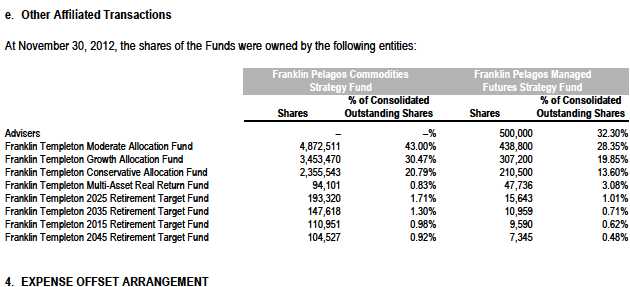
The Funds have entered into an arrangement with their custodian whereby credits realized as a result of uninvested cash balances are used to reduce a portion of the Funds' custodian expenses. During the period ended November 30, 2012, there were no credits earned.
Semiannual Report | 14
Franklin Alternative Strategies Funds
Notes to Consolidated Financial Statements (unaudited) (continued)
5. INCOME TAXES
For tax purposes, capital losses may be carried over to offset future capital gains, if any. At May 31, 2012, the Franklin Pelagos Commodities Strategy Fund had no capital loss carryforwards. The capital loss carryforwards for the Pelagos Managed Futures Strategy Fund were as follows:

At November 30, 2012, the cost of investments and net unrealized appreciation (depreciation) for income tax purposes were as follows:

Differences between income and/or capital gains as determined on a book basis and a tax basis are primarily due to differing treatments of bond discounts and premiums, non-deductible expenses, pass-through entity income and futures transactions.
6. INVESTMENT TRANSACTIONS
Purchases and sales of investments (excluding short term securities) for the period ended November 30, 2012, were as follows:

7. INVESTMENTS IN INSTITUTIONAL FIDUCIARY TRUST MONEY MARKET PORTFOLIO
The Funds invest in the Institutional Fiduciary Trust Money Market Portfolio (Sweep Money Fund), an open-end investment company managed by Advisers. Management fees paid by the Funds are reduced on assets invested in the Sweep Money Fund, in an amount not to exceed the management and administrative fees paid by the Sweep Money Fund.
Semiannual Report | 15
Franklin Alternative Strategies Funds
Notes to Consolidated Financial Statements (unaudited) (continued)
8. OTHER DERIVATIVE INFORMATION
At November 30, 2012, the Funds’investments in derivative contracts are reflected on the Consolidated Statements of Assets and Liabilities as follows:
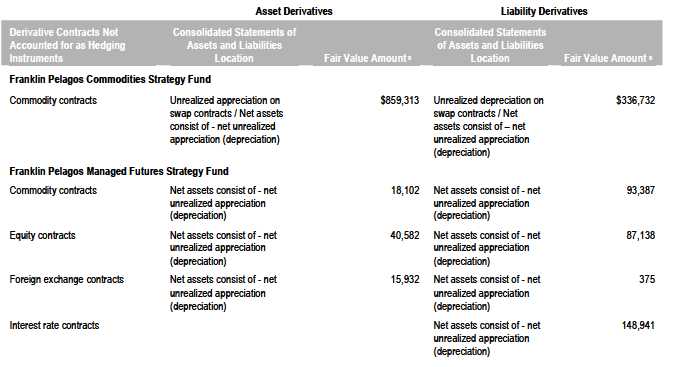
aIncludes cumulative appreciation/depreciation of futures contracts as reported in the Consolidated Statement of Investments. Only current day's variation margin is separately reported within the Consolidated Statements of Assets and Liabilities.
For the period ended November 30, 2012, the effect of derivative contracts on the Funds’Consolidated Statements of Operations was as follows:
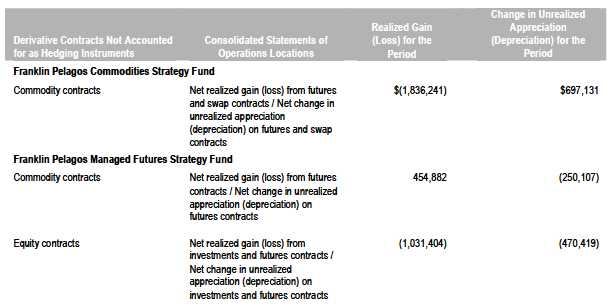
Semiannual Report | 16
Franklin Alternative Strategies Funds
Notes to Consolidated Financial Statements (unaudited) (continued)
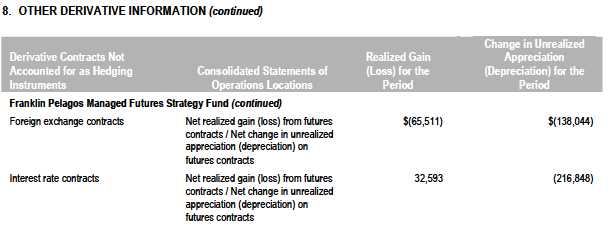
For the period ended November 30, 2012, the average month end market value of derivatives represented 5.77% and 7.26%, respectively, of average month end net assets. The average month end number of open derivative contracts for the period was 7 and 15, respectively.
See Note 1(c) regarding derivative financial instruments.
9. CREDIT FACILITY
The Funds, together with other U.S. registered and foreign investment funds (collectively, Borrowers), managed by Franklin Templeton Investments, are borrowers in a joint syndicated senior unsecured credit facility totaling $1.5 billion (Global Credit Facility) which matures on January 18, 2013. This Global Credit Facility provides a source of funds to the Borrowers for temporary and emergency purposes, including the ability to meet future unanticipated or unusually large redemption requests.
Under the terms of the Global Credit Facility, the Funds shall, in addition to interest charged on any borrowings made by the Funds and other costs incurred by the Funds, pay their share of fees and expenses incurred in connection with the implementation and maintenance of the Global Credit Facility, based upon their relative share of the aggregate net assets of all of the Borrowers, including an annual commitment fee of 0.08% based upon the unused portion of the Global Credit Facility, which is reflected in other expenses on the Consolidated Statements of Operations. During the period ended November 30, 2012, the Funds did not use the Global Credit Facility.
10. FAIR VALUE MEASUREMENTS
The Funds follow a fair value hierarchy that distinguishes between market data obtained from independent sources (observable inputs) and the Funds’own market assumptions (unobservable inputs). These inputs are used in determining the value of the Funds’financial instruments and are summarized in the following fair value hierarchy:
| i | Level 1 –quoted prices in active markets for identical financial instruments |
| i | Level 2 –other significant observable inputs (including quoted prices for similar financial instruments, interest rates, prepayment speed, credit risk, etc.) |
| i | Level 3 –significant unobservable inputs (including the Funds’ own assumptions in determining the fair value of financial instruments) |
The inputs or methodology used for valuing financial instruments are not an indication of the risk associated with investing in those financial instruments.
For movements between the levels within the fair value hierarchy, the Funds have adopted a policy of recognizing the transfers as of the date of the underlying event which caused the movement.
Semiannual Report | 17
Franklin Alternative Strategies Funds
Notes to Consolidated Financial Statements (unaudited) (continued)
| 10. | FAIR VALUE MEASUREMENTS (continued) |
| A | summary of inputs used as of November 30, 2012, in valuing the Funds’ assets and liabilities carried at fair value, is as follows: |
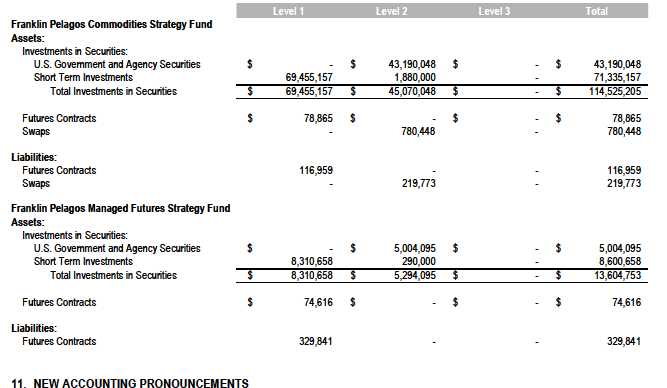
In December 2011, the Financial Accounting Standards Board issued Accounting Standards Update (ASU) No. 2011-11, Balance Sheet (Topic 210): Disclosures about Offsetting Assets and Liabilities. The amendments in the ASU enhance disclosures about offsetting of financial assets and liabilities to enable investors to understand the effect of these arrangements on a fund’s financial position. The ASU is effective for interim and annual reporting periods beginning on or after January 1, 2013. The Funds believe the adoption of this ASU will not have a material impact on their consolidated financial statements.
12. SUBSEQUENT EVENTS
The Funds have evaluated subsequent events through the issuance of the consolidated financial statements and determined that no events have occurred that require disclosure.

Semiannual Report | 18
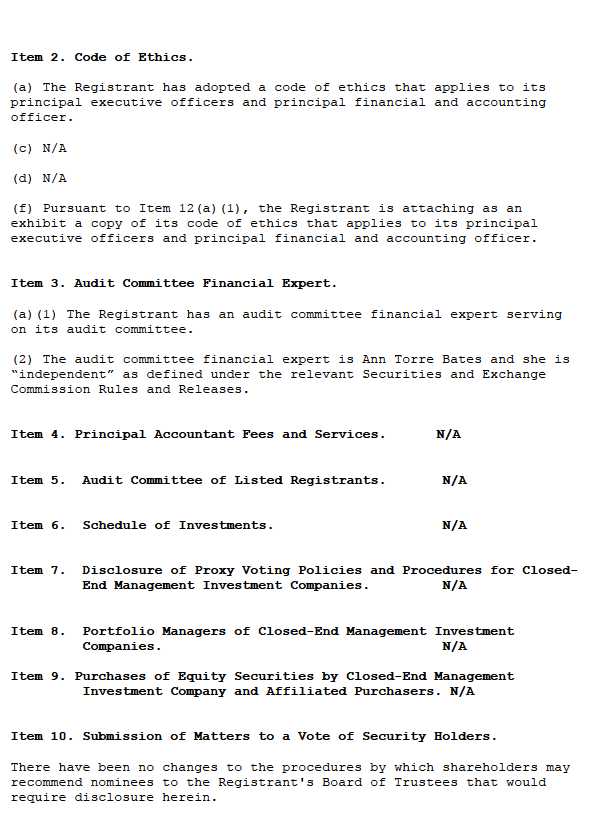
Item 11. Controls and Procedures.
(a) Evaluation of Disclosure Controls and Procedures. The Registrant maintains disclosure controls and procedures that are designed to ensure that information required to be disclosed in the Registrant’s filings under the Securities Exchange Act of 1934 and the Investment Company Act of 1940 is recorded, processed, summarized and reported within the periods specified in the rules and forms of the Securities and Exchange Commission. Such information is accumulated and communicated to the Registrant’s management, including its principal executive officer and principal financial officer, as appropriate, to allow timely decisions regarding required disclosure. The Registrant’s management, including the principal executive officer and the principal financial officer, recognizes that any set of controls and procedures, no matter how well designed and operated, can provide only reasonable assurance of achieving the desired control objectives.
Within 90 days prior to the filing date of this Shareholder Report on Form N-CSR, the Registrant had carried out an evaluation, under the supervision and with the participation of the Registrant’s management, including the Registrant’s principal executive officer and the Registrant’s principal financial officer, of the effectiveness of the design and operation of the Registrant’s disclosure controls and procedures. Based on such evaluation, the Registrant’s principal executive officer and principal financial officer concluded that the Registrant’s disclosure controls and procedures are effective.
(b) Changes in Internal Controls. There have been no changes in the Registrant’s internal controls or in other factors that could materially affect the internal controls over financial reporting subsequent to the date of their evaluation in connection with the preparation of this Shareholder Report on Form N-CSR.
Item 12. Exhibits.
(a) (1) Code of Ethics
(a)(2) Certifications pursuant to Section 302 of the Sarbanes-Oxley Act of 2002 of Laura F. Fergerson, Chief Executive Officer - Finance and Administration, and Robert G. Kubilis, Chief Financial Officer and Chief Accounting Officer
(b) Certifications pursuant to Section 906 of the Sarbanes-Oxley Act of 2002 of Laura F. Fergerson, Chief Executive Officer - Finance and Administration, and Robert G. Kubilis, Chief Financial Officer and Chief Accounting Officer
SIGNATURES
Pursuant to the requirements of the Securities Exchange Act of 1934 and the Investment Company Act of 1940, the registrant has duly caused this report to be signed on its behalf by the undersigned, thereunto duly authorized.
FRANKLIN ALTERATIVE STRATEGIES FUNDS
